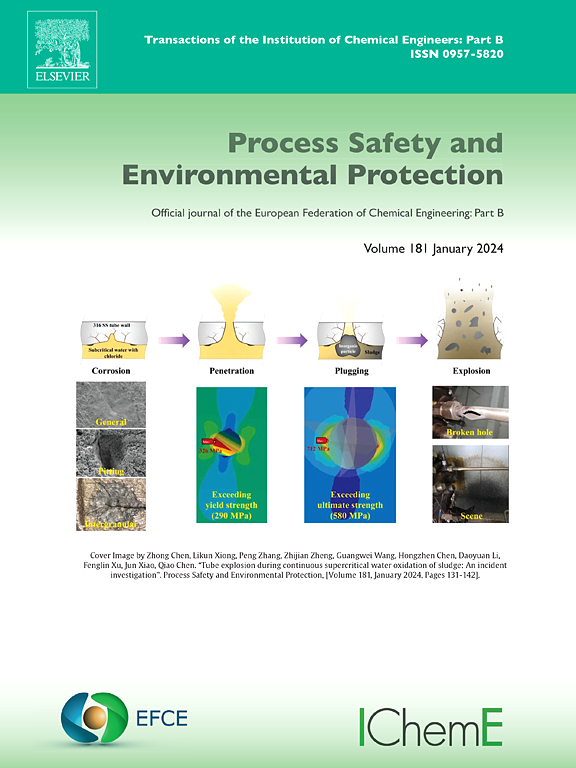Developing new spectral indices for identifying DOM sources in Liaohe River in a large-scale river basin by fluorescence spectroscopy and random forest model
IF 7.8
2区 环境科学与生态学
Q1 ENGINEERING, CHEMICAL
引用次数: 0
Abstract
Human activities can have a tremendous impact on rivers. The leaching of riparian soil, discharge of industrial wastewater, agricultural activities, and domestic sewage discharge can all introduce new dissolved organic matter (DOM) into rivers, thereby altering the structure of the original DOM in the river. In recent years, fluorescence traceability technology, especially three-dimensional fluorescence spectroscopy (3D-EEM) combined with parallel factor analysis (PARAFAC), has become an important tool to study the source and change of DOM. However, there are differences in the definition and calculation methods of the traditional fluorescence index, which leads to its limited applicability in different water bodies, so it is unable to accurately distinguish the sources of pollutants. Here, by combining the random forest model with three-dimensional to two-dimensional, taking the Liaohe River Basin as the research object, a new fluorescence traceability model is constructed. Divide it into three sources, i.e., originating from urb sewage, agricultural wastewater and soil organic matter, and thus defined as U-DOM, A-DOM, T-DOM, respectively. Based on the random forest model, special nodes of three-dimensional fluorescence spectrum can be identified, which can be tracked from three sources. It was closely related to the key peaks and nodes of EEM from three different sources, i.e., URB sewage (U-SoI: U-1/U-2 =(Ex: 245, Em: 440)nm/((Ex: 230, Em: 345)nm), agricultural wastewater (A-SoI: A-1/A-2 =( Ex: 245, Em: 325)nm/( Ex: 260, Em: 430)nm) and soil organic matter (T-SoI: T-1/T-2 =( Ex: 260, Em: 430)nm/( Ex: 285, Em: 365)nm). It is found that when U-SoI is greater than 0.9, it can be recognized as a typical U-DOM; When A-SoI is between 0.2 and 0.3, it indicates that it is A-DOM; When T-SoI is less than 0.5, it is displayed as T-DOM. Compared with the traditional fluorescence index traceability method, the new traceability model shows that the operation is more convenient and efficient, can provide more accurate traceability results, and can flexibly distinguish the source of pollutants according to the specific environment and pollution characteristics, so as to better adapt to the traceability requirements in different scenarios.

利用荧光光谱和随机森林模型建立大尺度流域辽河DOM源识别的新光谱指标
人类活动会对河流产生巨大的影响。河岸土壤的淋滤、工业废水的排放、农业活动和生活污水的排放都可以将新的溶解有机质(DOM)引入河流,从而改变河流中原有DOM的结构。近年来,荧光溯源技术,特别是三维荧光光谱(3D-EEM)与平行因子分析(PARAFAC)相结合,成为研究DOM来源和变化的重要工具。然而,传统荧光指数的定义和计算方法存在差异,导致其在不同水体中的适用性有限,无法准确区分污染物的来源。本文将三维到二维的随机森林模型相结合,以辽河流域为研究对象,构建了一种新的荧光溯源模型。将其分为城市污水、农业废水和土壤有机质三种来源,分别定义为U-DOM、A-DOM、T-DOM。基于随机森林模型,可以识别三维荧光光谱的特殊节点,可以从三个来源进行跟踪。与城市污水(U-SoI: U-1/U-2 =(Ex: 245, Em: 440)nm/((Ex: 230, Em: 345)nm)、农业废水(A-SoI: A-1/A-2 =(Ex: 245, Em: 325)nm/(Ex: 260, Em: 430)nm)和土壤有机质(T-SoI: T-1/T-2 =(Ex: 260, Em: 430)nm/(Ex: 285, Em: 365)nm)密切相关。发现当U-SoI大于0.9时,可识别为典型的U-DOM;当A-SoI在0.2 ~ 0.3之间时,表示为A-DOM;当T-SoI小于0.5时,显示为T-DOM。与传统的荧光指数溯源方法相比,新型溯源模型操作更加便捷高效,能够提供更加准确的溯源结果,并能根据具体环境和污染特征灵活区分污染物来源,从而更好地适应不同场景的溯源要求。
本文章由计算机程序翻译,如有差异,请以英文原文为准。
求助全文
约1分钟内获得全文
求助全文
来源期刊

Process Safety and Environmental Protection
环境科学-工程:化工
CiteScore
11.40
自引率
15.40%
发文量
929
审稿时长
8.0 months
期刊介绍:
The Process Safety and Environmental Protection (PSEP) journal is a leading international publication that focuses on the publication of high-quality, original research papers in the field of engineering, specifically those related to the safety of industrial processes and environmental protection. The journal encourages submissions that present new developments in safety and environmental aspects, particularly those that show how research findings can be applied in process engineering design and practice.
PSEP is particularly interested in research that brings fresh perspectives to established engineering principles, identifies unsolved problems, or suggests directions for future research. The journal also values contributions that push the boundaries of traditional engineering and welcomes multidisciplinary papers.
PSEP's articles are abstracted and indexed by a range of databases and services, which helps to ensure that the journal's research is accessible and recognized in the academic and professional communities. These databases include ANTE, Chemical Abstracts, Chemical Hazards in Industry, Current Contents, Elsevier Engineering Information database, Pascal Francis, Web of Science, Scopus, Engineering Information Database EnCompass LIT (Elsevier), and INSPEC. This wide coverage facilitates the dissemination of the journal's content to a global audience interested in process safety and environmental engineering.
 求助内容:
求助内容: 应助结果提醒方式:
应助结果提醒方式:


